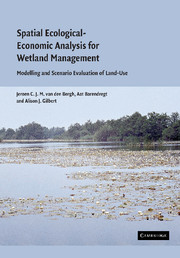 Spatial Ecological-Economic Analysis for Wetland Management
Spatial Ecological-Economic Analysis for Wetland Management Book contents
- Frontmatter
- Contents
- List of figures
- List of tables
- Preface
- 1 Introduction
- 2 Wetlands and science
- 3 Integrated modelling and assessment
- 4 Theoretical framework and method of integrated study
- 5 The Vecht area: history, problems and policy
- 6 Development scenarios for the Vecht area
- 7 The spatial–ecological model: hydrology and ecology
- 8 The spatial–economic model: agriculture, nature conservation and outdoor recreation
- 9 Performance indicators for the evaluation
- 10 Evaluation of the scenarios
- 11 Conclusions: policy and research implications
- References
- Index
7 - The spatial–ecological model: hydrology and ecology
Published online by Cambridge University Press: 24 November 2009
- Frontmatter
- Contents
- List of figures
- List of tables
- Preface
- 1 Introduction
- 2 Wetlands and science
- 3 Integrated modelling and assessment
- 4 Theoretical framework and method of integrated study
- 5 The Vecht area: history, problems and policy
- 6 Development scenarios for the Vecht area
- 7 The spatial–ecological model: hydrology and ecology
- 8 The spatial–economic model: agriculture, nature conservation and outdoor recreation
- 9 Performance indicators for the evaluation
- 10 Evaluation of the scenarios
- 11 Conclusions: policy and research implications
- References
- Index
Summary
Introduction
This chapter describes the hydrological and ecological modelling that underlies the integrated modelling approach in this study. In addition, some general characteristics of the intermediate results are discussed. Aggregation of the latter will be pursued in later chapters. Modelling the interaction of hydrology and vegetation of a wetland has three main elements.
A water quantity model, describing amounts of groundwater and surface water expected at specified locations in the present hydrological conditions;
A water quality model, describing the chemistry of groundwater and surface water at specified locations; and
An ecological model describing the presence of wetland plant species at specified locations, depending on local environmental conditions.
These three models interact, as summarised in Table 7.1. The water quantity model provided inputs to the water quality model, while both these models predict the abiotic conditions that serve as input for the ecological model.
A set of boundary conditions is needed to define the domains of the models. These boundary conditions can then be manipulated in scenarios. However, some input variables of the model are assumed to be static in the time domain adopted here, e.g. soil texture.
The modelling has a spatial dimension. Therefore, each of the models requires spatially differentiated input.
- Type
- Chapter
- Information
- Spatial Ecological-Economic Analysis for Wetland ManagementModelling and Scenario Evaluation of Land Use, pp. 116 - 128Publisher: Cambridge University PressPrint publication year: 2004


